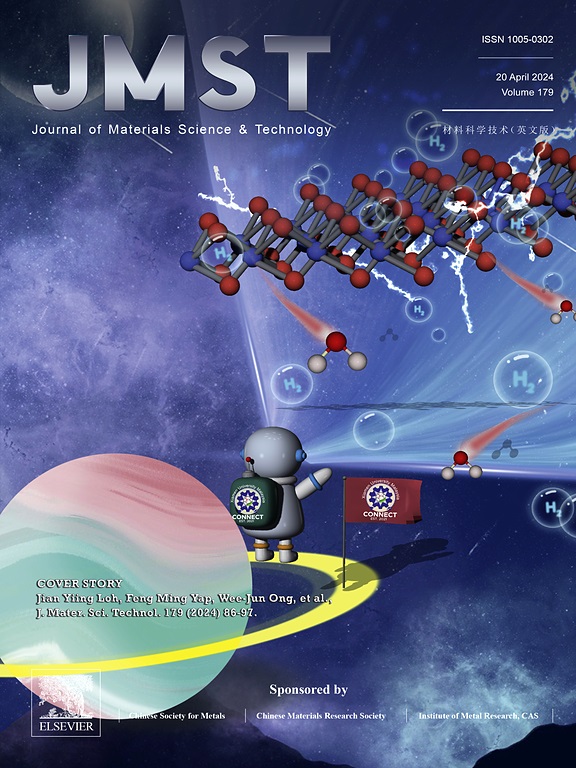利用稀有金属氢化物原位合成室温CO2甲烷化镍基催化剂:揭示反应途径和催化机理
IF 14.3
1区 材料科学
Q1 MATERIALS SCIENCE, MULTIDISCIPLINARY
引用次数: 0
摘要
通过与可再生氢的耦合作用,将二氧化碳转化为高附加值的化学燃料,已成为解决环境污染和能源供应问题的关键战略。然而,CO2分子的高化学惰性和CO2加氢过程中复杂的多电子转移过程带来了重大挑战,导致能量势垒大,产物选择性差。传统的化学催化剂通常需要恶劣的条件,如高温、高压和/或添加剂来克服这些障碍,加速缓慢的反应动力学。在此,我们报告了一种机械化学力驱动的策略,用于原位合成La2O3负载的Ni纳米颗粒(Ni/La2O3),该策略可以在室温下以LaNi5和H2/CO2混合气体为源材料实现高效的CO2甲烷化。实验结果有力地证实了在LaNi5-[CO2+H2]体系中CO2甲烷化是通过甲酸途径进行的。该途径包括LaNi5对H2的吸收,氢原子的解离,以及它们与形成的La2O3反应生成表面羟基。这些羟基在促进CO2在La2O3上的解离吸附中起着至关重要的作用,导致碳酸盐和碳酸氢盐中间体的形成。随后,这些中间体被来自LaNi5Hx的氢原子通量不断氢化,最终生成甲酸盐和甲烷。我们的实验和计算结果表明,通过与La2O3载体的直接相互作用来调节金属Ni活性位点中心,并将二氧化碳暴露于来自金属氢化物的活性氢原子中,可能是促进二氧化碳催化还原反应中新的反应性范式的有力策略。本文章由计算机程序翻译,如有差异,请以英文原文为准。

In situ synthesis of Ni-based catalyst for ambient-temperature CO2 methanation using rare-metal hydrides: Unveiling the reaction pathway and catalytic mechanism
Converting CO2 into high value-added chemical fuels through coupling with renewable hydrogen, has emerged as a pivotal strategy to address environmental pollution and tackle energy supply issues. However, the high chemical inertness of CO2 molecules and the complex multi-electron transfer processes involved in CO2 hydrogenation pose significant challenges, leading to large energy barriers and poor product selectivity. Traditional chemical catalysts typically require harsh conditions such as high temperatures, pressures, and/or additives to overcome these barriers and accelerate sluggish reaction kinetics. Herein, we report a mechanochemical-force-driven strategy for the in situ synthesis of Ni nanoparticles supported on La2O3 (Ni/La2O3), which enables efficient CO2 methanation at room temperature using LaNi5 and H2/CO2 mixed gas as source materials. The experimental findings assuredly corroborate that CO2 methanation proceeds through the formate route in the LaNi5-[CO2+H2] system. This pathway involves the absorption of H2 by LaNi5, dissociation of hydrogen atoms, and their reaction with the formed La2O3 to generate surface hydroxyl groups. These hydroxyl groups play a crucial role in facilitating the dissociative adsorption of CO2 on La2O3, resulting in the formation of carbonate and bicarbonate intermediates. Subsequently, these intermediates are continuously hydrogenated by the hydrogen atom flux from LaNi5Hx, ultimately producing formate and methane. Our experimental and computational results demonstrate that modulating a metallic Ni active site center through direct interaction with a La2O3 support and exposing CO2 to active hydrogen atoms sourced from metal hydrides may be a powerful strategy for promoting novel reactivity paradigms in CO2 catalytic reduction reactions.
求助全文
通过发布文献求助,成功后即可免费获取论文全文。
去求助
来源期刊

Journal of Materials Science & Technology
工程技术-材料科学:综合
CiteScore
20.00
自引率
11.00%
发文量
995
审稿时长
13 days
期刊介绍:
Journal of Materials Science & Technology strives to promote global collaboration in the field of materials science and technology. It primarily publishes original research papers, invited review articles, letters, research notes, and summaries of scientific achievements. The journal covers a wide range of materials science and technology topics, including metallic materials, inorganic nonmetallic materials, and composite materials.
 求助内容:
求助内容: 应助结果提醒方式:
应助结果提醒方式:


